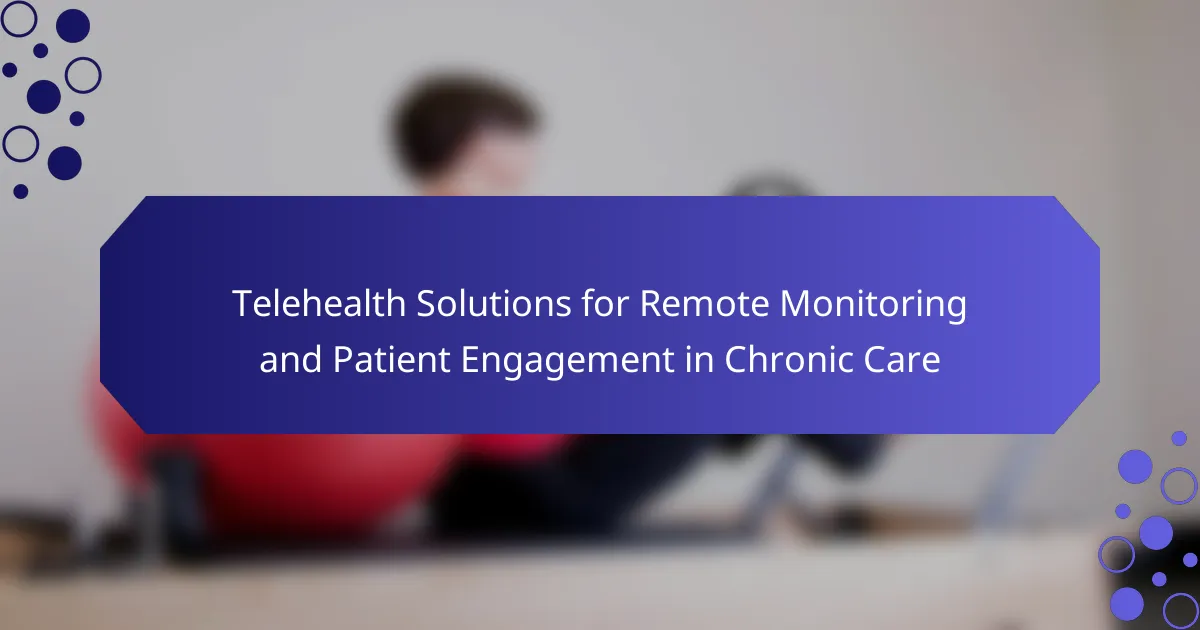Telehealth solutions improve remote monitoring and patient engagement for chronic care, enabling real-time health tracking and personalised care plans. These technologies reduce hospital visits and enhance communication between patients and providers. Key features include user-friendly interfaces, secure data transmission, and integration with electronic health records. Regulatory frameworks also shape the adoption and effectiveness of these innovative tools in managing chronic conditions.
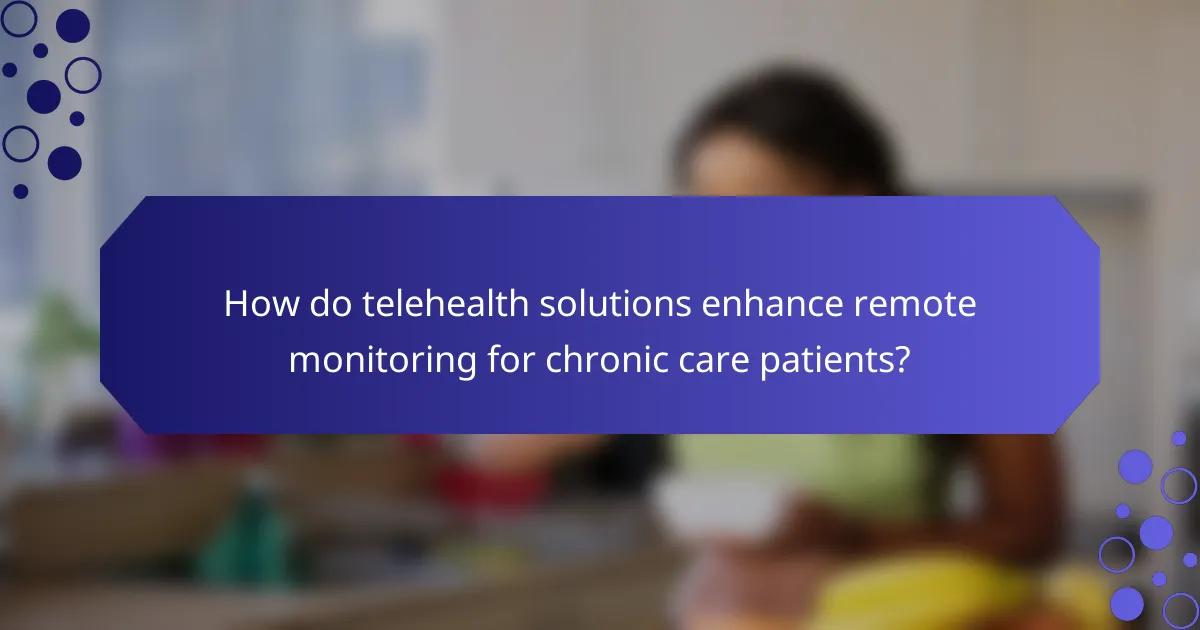
How do telehealth solutions enhance remote monitoring for chronic care patients?
Telehealth solutions significantly enhance remote monitoring for chronic care patients by providing real-time data access and improved patient engagement. These technologies facilitate continuous health tracking, enabling timely interventions and personalised care plans. Telehealth tools, such as wearable devices and mobile applications, allow patients to share vital signs with healthcare providers instantly. This proactive approach reduces hospital visits and enhances overall patient outcomes. Additionally, telehealth fosters better communication between patients and providers, leading to increased adherence to treatment regimens. As a result, chronic care patients experience improved quality of life and more effective management of their conditions.
What technologies facilitate remote patient monitoring in telehealth?
Telehealth solutions utilise various technologies for effective remote patient monitoring. These include wearable devices, mobile health applications, telecommunication tools, and cloud-based platforms that facilitate real-time data collection and patient engagement. Wearable devices, such as smartwatches, monitor vital signs, while mobile health apps enable patients to track their health metrics. Telecommunication tools, including video conferencing, allow healthcare professionals to interact with patients remotely. Cloud-based platforms store and analyse patient data, ensuring accessibility and security. These technologies enhance chronic care management by providing timely interventions and improving patient outcomes.
Which chronic conditions benefit most from remote monitoring?
Chronic conditions that benefit most from remote monitoring include diabetes, hypertension, heart disease, and asthma. Telehealth solutions enhance patient engagement and improve management of these illnesses. For instance, remote monitoring allows real-time tracking of vital signs, medication adherence, and symptom reporting. This proactive approach reduces hospital visits and improves health outcomes, particularly for patients with complex care needs.
How does remote monitoring improve patient outcomes?
Remote monitoring significantly enhances patient outcomes by enabling continuous health tracking and timely interventions. This proactive approach allows healthcare providers to identify issues early, reducing hospitalisations and improving chronic disease management. Telehealth solutions facilitate real-time communication, fostering patient engagement and adherence to treatment plans. As a result, patients experience better health metrics and overall quality of life.
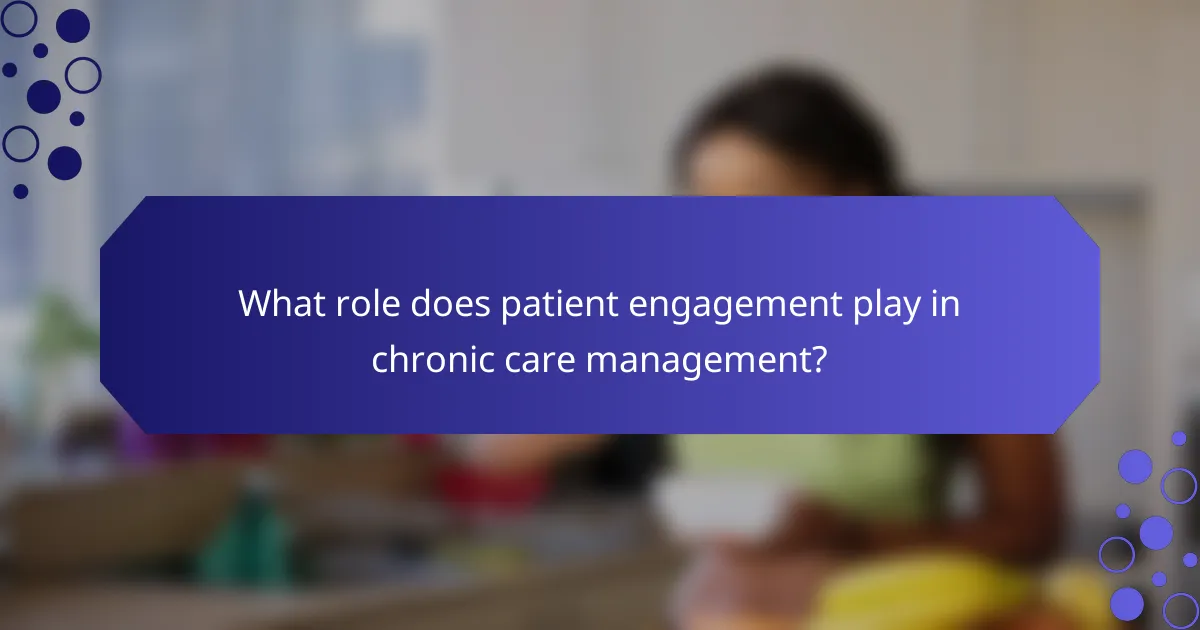
What role does patient engagement play in chronic care management?
Patient engagement significantly enhances chronic care management by improving adherence to treatment plans and fostering communication. Telehealth solutions facilitate this engagement by providing accessible remote monitoring tools. These tools allow patients to track their health metrics in real time, leading to timely interventions. Studies show that effective patient engagement can reduce hospital readmission rates by up to 30%. By leveraging telehealth, healthcare providers can personalise care plans, ensuring patients remain active participants in their health journey. This proactive approach not only improves outcomes but also enhances patient satisfaction and quality of life.
How can telehealth solutions foster better patient engagement?
Telehealth solutions enhance patient engagement by providing continuous support and real-time communication. These platforms facilitate personalised care plans, allowing patients to monitor their health actively. Remote monitoring tools enable timely interventions, improving health outcomes. Furthermore, educational resources within telehealth applications empower patients to make informed decisions about their care.
What strategies enhance communication between patients and healthcare providers?
Telehealth solutions enhance communication between patients and healthcare providers through real-time data sharing, personalised engagement, and remote monitoring. These strategies foster continuous interaction, improving patient adherence and satisfaction. For instance, virtual consultations allow for immediate feedback, while mobile health apps enable ongoing communication. As a result, patients feel more connected and involved in their care, leading to better health outcomes.
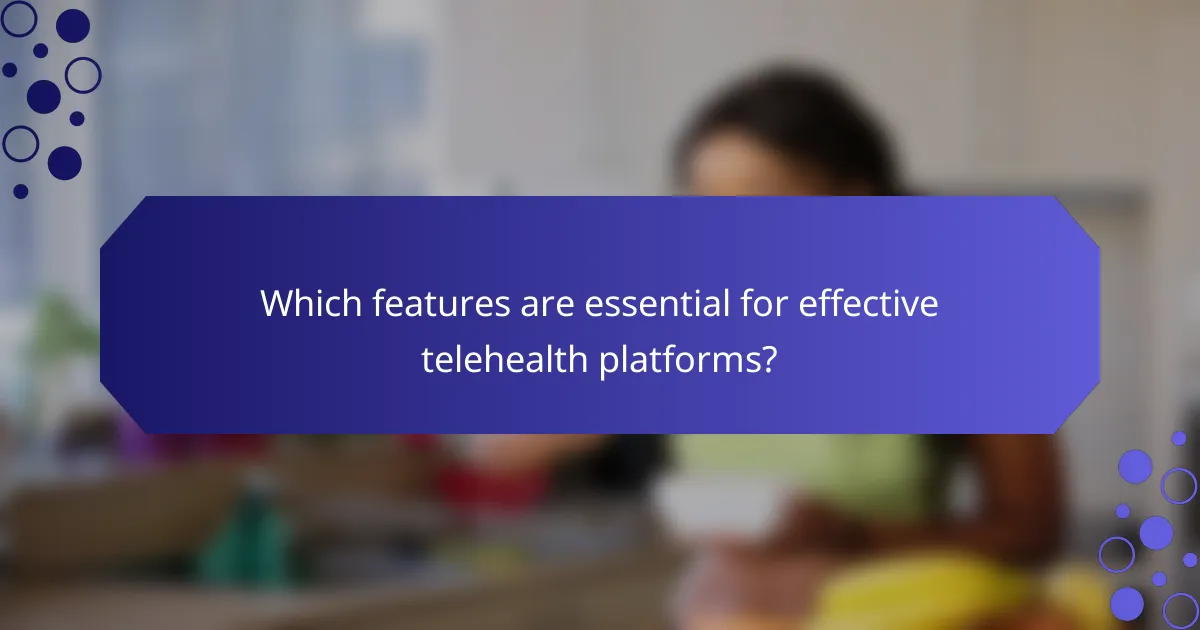
Which features are essential for effective telehealth platforms?
Essential features for effective telehealth platforms include user-friendly interfaces, secure data transmission, and real-time communication capabilities. These attributes enhance remote monitoring and patient engagement in chronic care. Integration with electronic health records (EHR) and customisable patient dashboards further improve usability. Additionally, analytics tools for tracking patient outcomes are crucial for ongoing care management.
What data security measures are crucial for telehealth solutions?
Data security measures crucial for telehealth solutions include encryption, access controls, and regular audits. Encryption protects patient data during transmission and storage. Access controls ensure only authorised personnel can access sensitive information. Regular audits help identify vulnerabilities and ensure compliance with regulations. Implementing these measures enhances patient trust and safeguards health information.
How do user interfaces impact patient satisfaction with telehealth?
User interfaces significantly enhance patient satisfaction with telehealth by improving usability, accessibility, and engagement. Intuitive designs facilitate easier navigation, leading to reduced frustration. Features like real-time chat and video consultations foster a sense of connection, which is crucial for chronic care management. Research indicates that user-friendly interfaces can boost patient adherence to treatment plans by up to 30%. Additionally, personalised dashboards that track health metrics enhance patient involvement, making them feel more in control of their health.
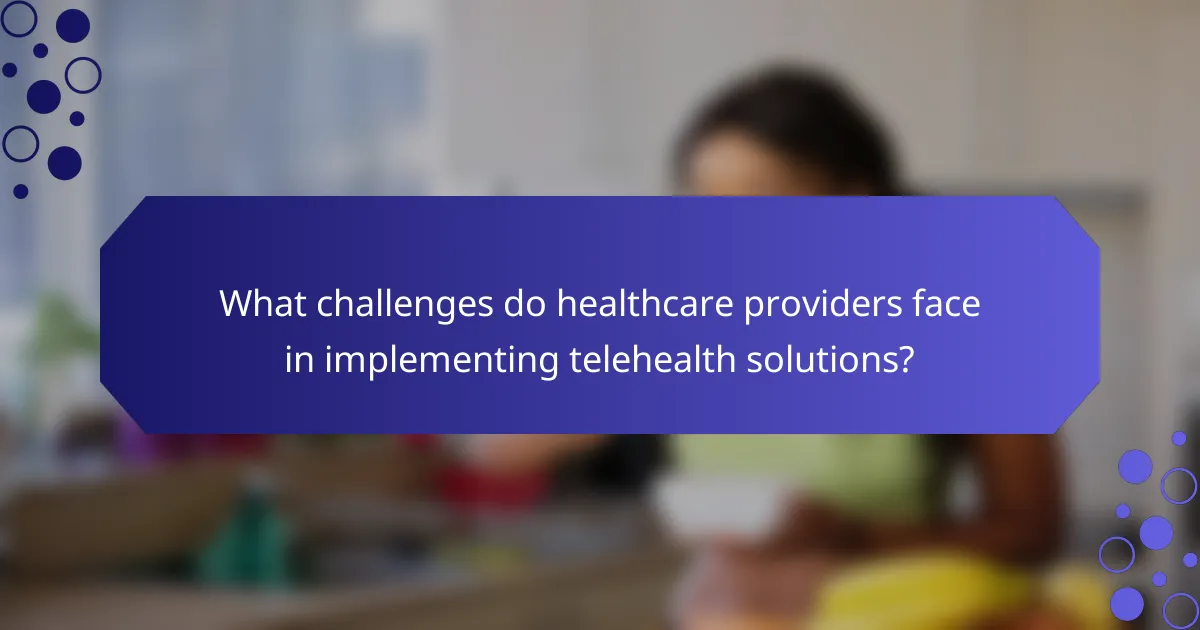
What challenges do healthcare providers face in implementing telehealth solutions?
Healthcare providers face several challenges in implementing telehealth solutions for chronic care. Technical issues, such as inadequate internet connectivity, hinder effective remote monitoring. Additionally, regulatory compliance and reimbursement policies create barriers to adoption. Providers also struggle with patient engagement, as some patients may lack familiarity with technology. Lastly, data security concerns pose risks that providers must address to maintain patient trust.
How can providers overcome technological barriers in telehealth?
Providers can overcome technological barriers in telehealth by implementing user-friendly platforms, ensuring robust internet connectivity, and providing technical support. These solutions enhance remote monitoring and patient engagement in chronic care.
Investing in training for both providers and patients is essential. Familiarity with technology reduces anxiety and increases usage rates. Additionally, integrating telehealth with existing healthcare systems streamlines workflows, improving efficiency.
Partnerships with technology vendors can facilitate access to innovative tools. These collaborations can lead to tailored solutions that address specific challenges faced by healthcare providers.
Lastly, gathering feedback from patients and providers helps identify persistent barriers. This data-driven approach allows for continuous improvement of telehealth services, ultimately enhancing patient care outcomes.
What are the common misconceptions about telehealth?
Many misconceptions about telehealth include beliefs that it lacks effectiveness, is only for minor issues, or cannot ensure patient privacy. These misunderstandings can hinder the adoption of telehealth solutions in chronic care management. Research shows that telehealth can effectively monitor chronic conditions, improve patient engagement, and provide comprehensive care. Additionally, telehealth platforms often implement robust security measures to protect patient data, addressing concerns about privacy.

How do regulatory frameworks influence telehealth practices?
Regulatory frameworks significantly shape telehealth practices by establishing guidelines that ensure patient safety and data privacy. These regulations influence the design and implementation of remote monitoring technologies and patient engagement strategies in chronic care. Compliance with laws, such as HIPAA in the U.S., mandates secure data handling and patient consent processes. Additionally, reimbursement policies affect the accessibility and adoption of telehealth solutions, encouraging providers to integrate these services into chronic care management. As a result, regulatory frameworks foster a structured environment that promotes innovation while safeguarding patient interests.
Which policies affect telehealth reimbursement in different regions?
Policies affecting telehealth reimbursement vary significantly across regions. Key factors include state regulations, payer policies, and federal guidelines that govern coverage and payment models.
State regulations often determine the scope of practice for telehealth providers, impacting reimbursement eligibility. Payer policies differ as private insurers may offer varying coverage levels compared to public programmes like Medicare and Medicaid. Federal guidelines, such as those from the Centres for Medicare & Medicaid Services, set standards for telehealth services, influencing reimbursement rates.
Additionally, some regions may have unique attributes, such as specific laws mandating telehealth coverage or incentives for remote monitoring services. Understanding these factors is essential for healthcare providers to navigate reimbursement effectively.
How do privacy laws impact telehealth implementation?
Privacy laws significantly influence telehealth implementation by establishing guidelines for data protection and patient consent. Compliance with regulations like HIPAA ensures secure handling of sensitive health information, which fosters patient trust and engagement. Telehealth solutions must integrate robust security measures to protect patient data during remote monitoring and consultations. Additionally, varying state laws can complicate telehealth service delivery, requiring providers to stay informed about local regulations. This complexity can impact the adoption rates of telehealth in chronic care management.
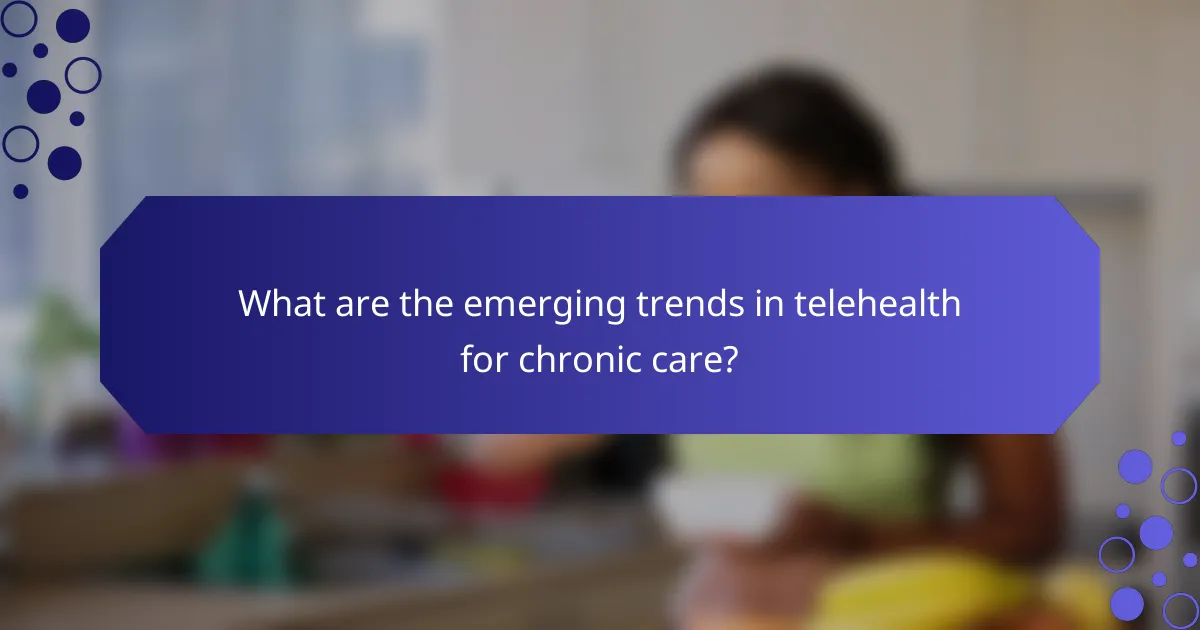
What are the emerging trends in telehealth for chronic care?
Telehealth is increasingly focusing on remote monitoring and patient engagement for chronic care. Key trends include the use of wearable devices for real-time health tracking, AI-driven analytics for personalised treatment plans, and enhanced patient portals for improved communication. These innovations aim to empower patients, increase adherence to treatment, and reduce hospital visits. As a result, telehealth solutions are becoming essential in managing chronic conditions effectively.
How is artificial intelligence shaping telehealth solutions?
Artificial intelligence is transforming telehealth by enhancing remote monitoring and patient engagement in chronic care. AI algorithms analyse patient data, providing personalised insights and alerts for timely interventions.
AI-driven chatbots facilitate patient interactions, ensuring continuous support and education. These tools improve adherence to treatment plans, ultimately leading to better health outcomes.
Predictive analytics identify potential health declines, enabling proactive management of chronic conditions. This capability reduces hospitalisations and improves quality of life for patients.
Integration of AI with wearable devices offers real-time health monitoring, empowering patients to take charge of their health. These advancements exemplify how AI shapes effective telehealth solutions.
What future innovations can enhance remote patient monitoring?
Innovations such as AI-driven analytics and wearable technology can significantly enhance remote patient monitoring. AI can analyse patient data in real-time, predicting health issues before they escalate. Wearable devices provide continuous health metrics, improving patient engagement and adherence to care plans. Enhanced data security measures will also ensure patient privacy while facilitating seamless communication between patients and healthcare providers. Integrating telehealth platforms with electronic health records can streamline workflows, allowing for more personalised care.
What role do patient feedback and analytics play in telehealth development?
Patient feedback and analytics are crucial for refining telehealth solutions. They enhance remote monitoring and patient engagement in chronic care by providing insights into user experiences and outcomes.
Patient feedback helps identify areas for improvement, ensuring that services align with patient needs. Analytics track engagement metrics, revealing how patients interact with telehealth platforms. This data informs adjustments to improve user satisfaction and care quality.
Moreover, leveraging analytics can predict patient behaviour, allowing providers to proactively address potential issues. As a result, telehealth solutions become more effective, leading to better chronic care management.
Incorporating these elements fosters a patient-centred approach, enhancing the overall effectiveness of telehealth services.
What best practices should be followed for optimising telehealth solutions?
To optimise telehealth solutions for remote monitoring and patient engagement in chronic care, prioritise user-friendly interfaces and robust security measures. Ensure seamless integration with existing healthcare systems to enhance data flow. Regularly update software to incorporate the latest features and compliance standards. Foster patient engagement through personalised communication strategies and educational resources.
